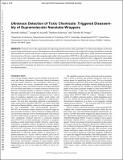Ultratrace Detection of Toxic Chemicals: Triggered Disassembly of Supramolecular Nanotube Wrappers
Author(s)
Ishihara, Shinsuke; Azzarelli, Joseph M.; Krikorian, Markrete; Swager, Timothy M
DownloadUltratrace detection.pdf (4.075Mb)
PUBLISHER_POLICY
Publisher Policy
Article is made available in accordance with the publisher's policy and may be subject to US copyright law. Please refer to the publisher's site for terms of use.
Terms of use
Metadata
Show full item recordAbstract
Chemical sensors offer opportunities for improving personal security, safety, and health. To enable broad adoption of chemical sensors requires performance and cost advantages that are best realized from innovations in the design of the sensing (transduction) materials. Ideal materials are sensitive and selective to specific chemicals or chemical classes and provide a signal that is readily interfaced with portable electronic devices. Herein we report that wrapping single walled carbon nanotubes with metallo-supramolecular polymers creates sensory devices with a dosimetric (time- and concentration-integrated) increase in electrical conductivity that is triggered by electrophilic chemical substances such as diethylchlorophosphate, a nerve agent simulant. The mechanism of this process involves the disassembly of the supramolecular polymer, and we demonstrate its utility in a wireless inductively powered sensing system based on near-field communication technology. Specifically, the dosimeters can be powered and read wirelessly with conventional smartphones to create sensors with ultratrace detection limits.
Date issued
2016-07Department
Massachusetts Institute of Technology. Department of ChemistryJournal
Journal of the American Chemical Society
Publisher
American Chemical Society (ACS)
Citation
Ishihara, Shinsuke et al. “Ultratrace Detection of Toxic Chemicals: Triggered Disassembly of Supramolecular Nanotube Wrappers.” Journal of the American Chemical Society 138, 26 (June 2016): 8221–8227 © 2016 American Chemical Society
Version: Author's final manuscript
ISSN
0002-7863
1520-5126